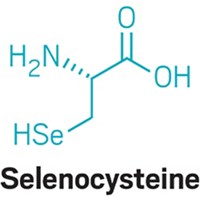Advertisement
Grab your lab coat. Let's get started
Welcome!
Welcome!
Create an account below to get 6 C&EN articles per month, receive newsletters and more - all free.
It seems this is your first time logging in online. Please enter the following information to continue.
As an ACS member you automatically get access to this site. All we need is few more details to create your reading experience.
Not you? Sign in with a different account.
Not you? Sign in with a different account.
ERROR 1
ERROR 1
ERROR 2
ERROR 2
ERROR 2
ERROR 2
ERROR 2
Password and Confirm password must match.
If you have an ACS member number, please enter it here so we can link this account to your membership. (optional)
ERROR 2
ACS values your privacy. By submitting your information, you are gaining access to C&EN and subscribing to our weekly newsletter. We use the information you provide to make your reading experience better, and we will never sell your data to third party members.
Biological Chemistry
Expanding The RNA Roster
Chemical screen finds new small molecule-RNA conjugates
by Celia Henry Arnaud
April 27, 2009
| A version of this story appeared in
Volume 87, Issue 17
Many new biological roles for RNA have been discovered in recent years, but discoveries on RNA's chemical diversity have not kept pace with findings on its functional diversity. A team of researchers at Harvard University has now uncovered a new type of small molecule-RNA conjugate—coenzyme A (CoA)-linked RNA—and reports a screening method that offers the possibility of finding many more classes of such RNA structural variations (Proc. Natl. Acad. Sci. USA, DOI: 10.1073/pnas.0900528106).
"The chemical diversity of biological RNA is greater—maybe significantly greater—than is currently understood," says chemistry professor and team leader David R. Liu.
"In the age of genomics, we tend to think that RNAs are made of only the four standard nucleotides," says Ronald R. Breaker, a professor of molecular, cellular, and developmental biology at Yale University. "But a quick glance at transfer RNAs, ribosomal RNAs, or even 5'-capped messenger RNAs reminds us how strangely modified some RNAs can become. The work by the Liu lab reveals another collection of RNA modifications and provides the methods to make even more discoveries."
The new approach is "unusually broad and not dependent on a particular small-molecule structure, RNA sequence, or class of RNAs," Liu says. First, the researchers isolate RNA from cells and use size-exclusion separation to eliminate molecules smaller than about 2,500 daltons so that all the small molecules they find are bound to RNA. They then cleave small molecules from the RNA. After a second round of size-exclusion separation, they analyze by liquid chromatography-mass spectrometry the small molecules left after discarding the macromolecules.
The mass spectral analysis reveals a number of small molecules associated with RNA. Some of these were previously known, such as the amino acids of aminoacylated tRNAs. But Liu and coworkers also observed some previously unknown conjugates, including CoA- and CoA thioester-linked RNA. A variety of additional novel small molecule-RNA conjugates uncovered by the work are also being studied by the group.
Liu and coworkers have yet to identify the RNA sequences that are associated with CoA. All they know at this point is that the CoA-linked RNA (or multiple RNAs) contains fewer than 200 nucleotides.
They don't know what biological function—if any—these conjugates have, but Liu speculates about a range of possibilities. They could be "evolutionary fossils" that no longer have a role. If they do have a role, they could help control RNA's lifetime or location. Liu's "wildest guess" is that they might participate in some form of templated synthesis.
"The fact that some of these modifications carry coenzyme A derivatives is particularly intriguing," Breaker says. More than a decade ago, Breaker and Gerald F. Joyce of Scripps Research Institute showed that a natural splicing ribozyme could be forced to incorporate coenzymes. "These new findings suggest that modern cells indeed find it useful to covalently link RNA and coenzymes," Breaker notes.







Join the conversation
Contact the reporter
Submit a Letter to the Editor for publication
Engage with us on Twitter